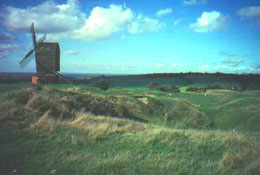| Fingerprints of the maker |
| Why did they adapt the clay? | |
| Earthenware clays are also secondary clays, and are many and various. Earthenware clay is the most common clay type used in the pottery recovered from archaeological excavations from the Neolithic to the late medieval period. The potter would choose the best clays and adapt them for the task ahead. Some vessels needed to be fireproof, others non-porous. Inclusions were added to "open" the clay or to improve the firing of a vessel. |

Clay diggings on Brill Common in Buckinghamshire have changed the landscape |
|
What did they need? |
Fingerprints ... |
The making of the vessel |
|
© Copyright University of Oxford, Ashmolean Museum, 2000 The Ashmolean Museum retains the copyright of all materials used here and in its Museum Web pages. last updated: jcm/27-jun-2000 |